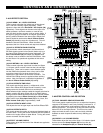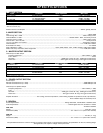
CONTROLS AND CONNECTIONS
6
(5) CHANNEL PEAK LED
The Peak LED illuminates when a channel input is overloading.
It detects the peak level after the Equalizer Controls (7) and will
light just before clipping to warn that the signal is approaching
overload. You do not want the Peak LED to light except very
intermittently. If it lights persistently, reduce the Trim Control (4).
(6) LOW CUT FILTER
Use this Low-Cut (high-pass) filter (18 dB/octave, -3 dB at 75Hz)
for reducing floor rumble, popping, breathing noises, woolly
bottom end, and to tighten up channels in a mix, etc. It is most
effective when used carefully in conjunction with the Equalizer
Controls (7).
(7) EQUALIZER CONTROLS
All channels are fitted with a three-band EQ — High, Mid and
Low controls. The Mid control has a parametric Mid Freq control
with a 250Hz-6KHz range. All three bands have up to 15 dB of
cut and boost, with a center detent for OFF. The frequency
response is flat when all three EQ knobs are in the center detent
position. The High and Low shelving controls have their
frequencies fixed at 12 KHz and 80Hz respectively. The Mid
control has a parametric Frequency Control. This control can be
used to locate the frequency of the midrange tones that you want
to accentuate or cut. The channel EQ is a valuable feature of
the mixer as it allows the user to control the tonal characteristics
of each channel separately. For example, boosting the Low can
fatten the sound, add bass to vocals, or extra punch to bass,
drums and synths. The Mid control, with the Mid Freq set to
higher frequencies, can be used to define percussive instruments
or bring out the edge of vocals; when set to lower frequencies
the Mid can boost low midrange frequencies to fatten up guitars,
toms, or bring warmth to vocals. Adjusting the High control can
provide a crisp sounding high end. Another very important, yet
often overlooked technique is to use the EQ to subtract from the
mix. Cutting the High control can reduce unwanted sibilance,
hiss, cymbals, or high frequency feedback, while attenuating the
Mid or Low can also eliminate feedback or clear up a muddy
sounding mix. The Mid Freq control can also be used to reduce
any feedback from 250Hz to 6Khz. Cutting the High and Low,
then pushing up the Channel Fader (13) is equivalent to mid
range boost!
[Note: Always reset a channel’s input Trim Control (4) (or
external device’s output level) after altering the amount of
equalization.]
The key to successful equalization is to avoid excess. Too much
equalization on the input channels will result in a mix that is
smeared together with nothing specifically defined. During
rehearsals, experiment with the equalizer controls on various
instruments, vocals and combinations of these mixed together to
become familiar with various equalizer settings.
(8) AUX 1 CONTROL (PRE-FADER)
The channel Aux 1 control is mono, post-EQ, and pre-fader
meaning the signal level sent to the Aux Send 1 bus will be
unaffected by the channel fader setting. This configuration is
ideal for almost all monitoring purposes: for example, for a
separate stage monitor mix in live performances or a studio room
monitor in recording applications, such as for a headphone cue
system.
(9) AUX 2 / EFFECT CONTROL (POST-FADER)
This control adjusts the level of signal sent to the Aux Send 2 or
the internal DSP Echo Effects.
The channel Aux 2 control is mono, post-EQ, and post-fader
meaning the signal level sent to the Aux 2 bus will be affected by
the channel fader setting. For almost all effects send purposes,
you will want to use the post-fader Aux 2, so that when a fader
level is adjusted, any reverb send from that channel follows the
fader. Otherwise, when the fader is pulled down, the reverb from
that channel would still be audible. You can also use this Aux 2
send to feed inputs of a multi-track recorder or any other
unbalanced line level application. On the other hand, for cueing
purposes and monitor amplifiers, use the pre-fader Aux 1 (i.e.
independent of the channel fader).
The Aux 2 Effect Send controls also adjust the level sent by each
channel to the internal DSP (Digital Sound Processor) Echo
Effects. Either the Aux Send 2 or internal Echo Effects can be
selected with the Aux 2 / Eff Enable Button (15).
(10) PAN
The channel Pan positions the output of the channel in the
left/right stereo field of the Master mix and also pans between 1
and 2 in the Group mix. Its constant-power design ensures there
are no level discrepancies whether a signal is hard-panned,
center-stage, or somewhere in-between.
(11) L-R SELECT SWITCH
When the L-R switch is selected (button depressed), the post
fader channel signal is fed to the Master Stereo Volume Faders
(24).
(12) GROUP SELECT SWITCH
When the G1-2 switch is selected (button depressed), the
channel signal is fed to the G1-2 bus, controlled by the Group 1-
2 Volume Faders (22). This signal is post channel fader and the
stereo placement is adjusted by the Pan control. The Group bus
offers you a second stereo submix with its own stereo G1-2
submaster faders. This submix can be sent to the Master Stereo
Volume Faders (24) by enabling the Group To Main Switch
(23). The Group Mix can be used as a convenient mixing aid
both live and in the studio; for example, to combine the outputs
of all drum channels onto just 1 or 2 submaster faders, or to mix
together a vocal quartet and then control their combined level in
the Master Mix, or to route separately to multi-track recorders.
The Group Select Switch can also be used to monitor the
channel signal in the headphones, without sending the signal to
the main outputs, with the L-R Select Switch (11) off.
(13) CHANNEL FADER
The channel faders determine the output signal level to the
Master Mix or Group 1-2 buses. They offer a smooth logarithmic
taper more often associated with much more expensive consoles
for optimum control of the signal.














